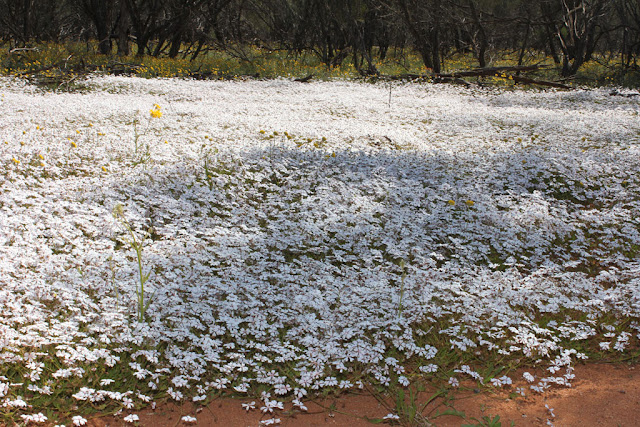September 4th
It doesn’t take long for the scenery to change from coastal
to dusty outback. We drove further east and inland today through what is known
as Australia’s Golden Outback as many of the towns were originally gold
prospecting towns and the surrounding areas feature a host of old mining pits
and relics from the wild Australian gold rush era. Gold mining still continues on
a small scale today in a number of these areas.
There are loads of road trains and mining equipment vehicles
out on these roads which can be very disconcerting to see especially when they
are bearing down upon you. Today we had the biggest one we have seen yet coming
towards us and you know you have to pull right over and stop when there are two
escort vehicles preceding it saying wide load. We got off the road quick smart
and the car shook as this truck passed us.
A stop for leg stretching at Meekatharra which is the
largest centre in the Murchison region and is apparently a thriving mining,
sheep and cattle district – you wouldn’t know it from stopping in town! So
often we pull up to these country towns and wonder where all the people are and
what the hell they do there. Got a good coffee and home-made lemon cheesecake
and cherry ripe slice from a food van on the side of the main street though and
ate it under a date palm. Didn’t realise it was a date palm to start with. We
had been sitting there a while and the conversation went something like this:
Jo – “Aren’t people grubby – someone has left a whole lot of
rotten dates all over the ground here. There is a bin just over there!!”
Stephen (looking up) – “Hmmmm, I think the tree is the
culprit. It’s a date palm sweetie!!”
Jo – “Oh…….”
Next stop was Wiluna and this is really the beginning of our
next adventure and the start of some real remote travel. We needed some permits
for the roads we are going to travel on for the next week or so and these hadn’t
all come through yet. Taking advantage of mobile phone coverage and Internet
access we made some calls and got our final permits sorted. To date, no-one has
ever looked at the permits we have arranged for various parts of our journey
but we always want to do the right thing. We fought with 20 billion flies while
we had lunch and did some last restocking of minor groceries paying $7.50 for
two avocados.
Two major and famous four wheel drive tracks begin from
Wiluna – the Canning Stock Route and the Gunbarrel Highway. We are keen to do
both of these tracks in their entirety at some stage however, on this trip we
are content to get a sneak peak at the Canning and drive part of the Gunbarrel.
We left Wiluna and drove on the first part of the Canning
Stock Route to see Well 1. The Canning runs from Wiluna to Halls Creek, is
1,850km long and is the longest historic stock route in the world. In the early 1900’s, Alfred Canning, a surveyor,
was appointed to survey a stock route that would cross the Great Sandy Desert,
the Little Sandy Desert and the Gibson Desert. He needed to find significant
water sources (enough for 800 head of cattle) a day’s walk apart where wells
could be dug and enough good grazing land to sustain this number of cattle
during the journey. Pretty big call but he was successful making the journey
from Wiluna to Halls Creek in less than 6 months. Between 1908 and 1910, the
construction of the stock route took place including the digging of 48 wells
and water troughs. Just 7km from Wiluna is Well 1 and this is where we popped
our head in to have a look at the ruins of this first wells.
A further 20km along the Canning and off the track a bit is
North Pool where were stayed the night. A great spot near a water hole under
fantastic trees – it was lovely sitting by the water that evening and again in
the morning being visited by quite an array of birds coming down to get their
daily drink.







































































